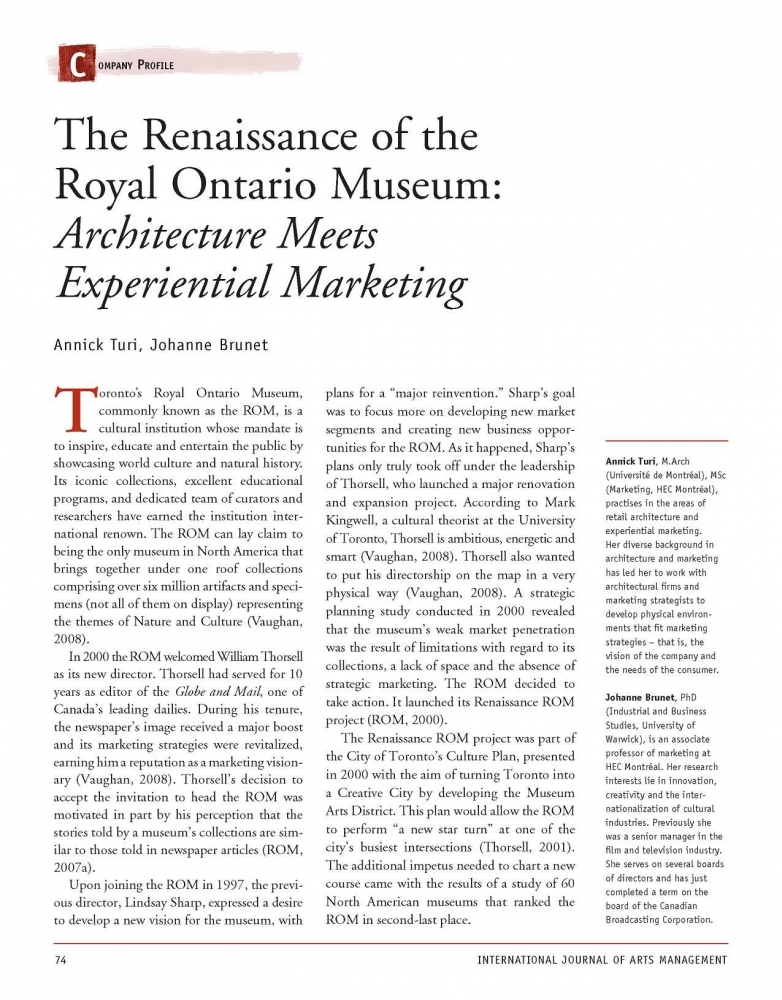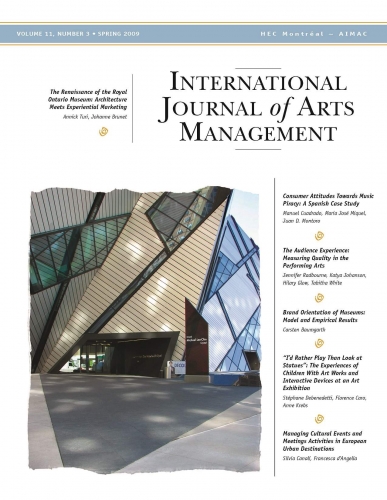The Renaissance of the Royal Ontario Museum: Architecture Meets Experiential Marketing
Produit: Article
21,00 $ CA
Annick Turi, Johanne Brunet
Annick Turi, M.Arch (Université de Montréal), Msc (Marketing, HEC Montréal), practises in the areas of retail architecture and experiential marketing. Her diverse background in architecture and marketing has led her to work with architectural firms and marketing strategists to develop physical environments that fit marketing strategies – that is, the vision of the company and the needs of the consumer.
Johanne Brunet, PhD (Industrial and Business Studies, University of Warwick), is an associate professor of Marketing at HEC Montréal. Her research interests lie in innovation, creativity and the internationalization of cultural industries. Previously she was a senior manager in the film and television industry. She serves on several boards of directors and has just completed a term on the board of the Canadian Broadcasting Corporation.
ABSTRACT
The Royal Ontario Museum provides an eloquent case study of the role that architecture can play in the reinvention of an experiential product. Architecture has enhanced the museumgoing experience at the ROM through renovation of the institution’s physical aspects and their adaptation to the needs of contemporary visitors. It has enabled the museum to reassert its positioning and differentiation strategy by offering a plurality of experiences and promoting innovation. It also serves as a tangible sign whose distinct symbolism and thematics guide consumers through the process of consumption thanks to the creation of a unique atmosphere, the presentation of content and environmental variables. The daring architectural design and aesthetics have also helped to renew and promote the ROM’s brand identity. Architecture has emerged as a change agent, by virtue of its revitalization of the museum product and ancillary services; harmonious integration of old and new, interior and exterior; involvement of visitors in the design and construction processes; and creation of a 21st-century architectural icon.
KEYWORDS
Marketing, experiential marketing, brand, design, architecture, creativity
RÉSUMÉ
Le cas du Royal Ontario Museum permet de constater l’apport de l’architecture à la rénovation d’un produit expérientiel. L’architecture a rehaussé l’expérience de consommation muséale par la rénovation des contextes expérientiels physiques adaptés aux nouveaux besoins des visiteurs. Elle a permis au musée d’affirmer son positionnement et sa stratégie de différentiation en offrant des expériences diverses et en encourageant l’innovation. Elle a également été un outil important comme indice tangible guidant les consommateurs dans leur processus de consommation en véhiculant un symbolisme et une thématique distincts grâce à la création d’une ambiance particulière, à la mise en scène du contenu et aux variables environnementales. De plus, elle a contribué à renouveler et à véhiculer l’identité de la marque par un design et une esthétique audacieux. L’architecture a émergé comme étant un vecteur de changement dans la rénovation du produit muséal et dans l’extension de l’offre en proposant des services connexes adaptés au contenu, en intégrant le nouveau à l’ancien et l’intérieur à l’extérieur, en proposant une nouvelle expérience, soit le processus de conception/construction architecturales, et en créant une icône architecturale digne du XXIe siècle.
MOTS CLÉS
Marketing, marketing expérientiel, marque, design, architecture, créativité
RESUMEN
El caso del Royal Ontario Museum nos permite apreciar el aporte de la arquitectura en el marco de la renovación de un producto experiencial. La arquitectura incrementó la experiencia de consumo museal mediante la renovación de contextos experienciales físicos adaptados a las necesidades de los nuevos visitantes. Le permitió al museo afirmar su posicionamiento y estrategia de diferenciación, ofreciendo experiencias diversas y promoviendo la innovación. También fue una herramienta importante como indicador tangible para guiar a los consumidores en su proceso de consumo vinculando un simbolismo y una temática distintiva gracias a la creación de un ambiente particular, a la puesta en escena del contenido y a las variables ambientales. También contribuyó a renovar y vincular la identidad de la marca por medio de un diseño y una estética audaz. La arquitectura emergió como un vector de cambio en la renovación del producto museal y en la extensión de la oferta proponiendo servicios conexos adaptados al contenido, integrando lo nuevo con lo viejo, el interior con el exterior, proponiendo una nueva experiencia, la del proceso de diseño y construcción arquitectónicos, a la vez que se crea un icono arquitectural digno del siglo XXI.
PALABRAS CLAVE
Comercialización, comercialización experiencial, marca, diseño, arquitectura, creatividad

